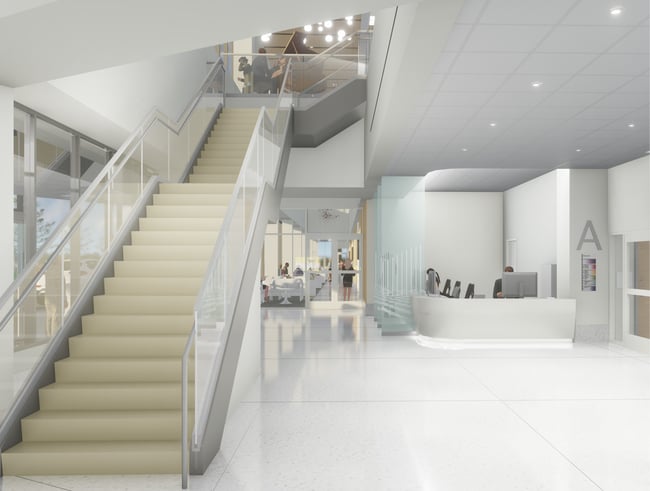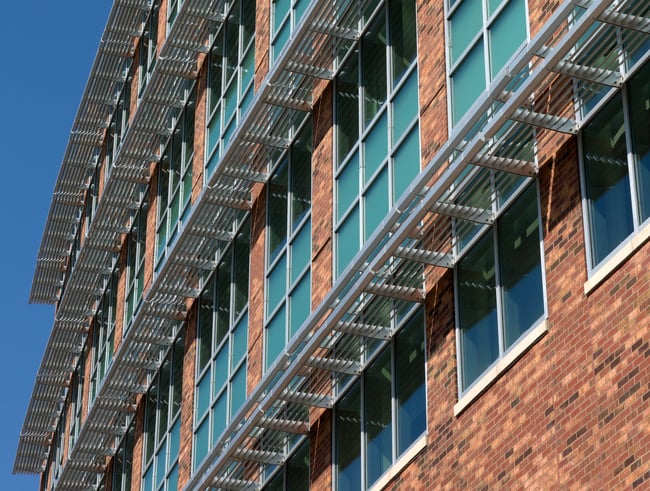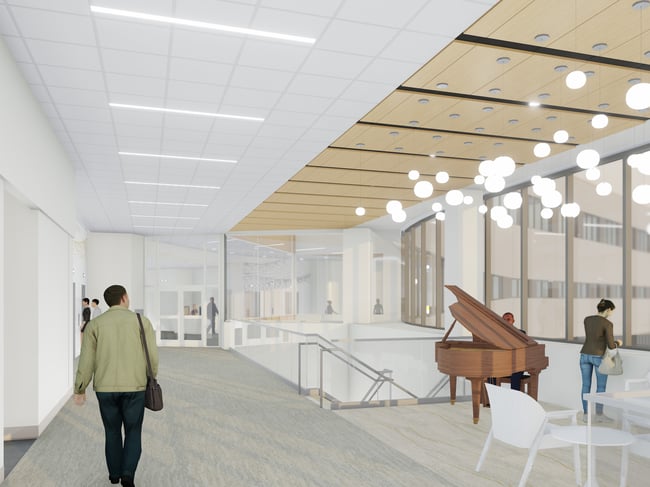Building Materials for Healthcare Projects: Considerations and Best Practices

Selecting materials and finishes can be one of the more complex aspects of a healthcare project. In addition to cost and aesthetics, design teams and their clients must consider durability, cleanability, and the health and safety of patients, staff, and visitors.
At Neumann Monson, we have worked on several recent healthcare projects. Our work with the University of Iowa Hospitals and Clinics (UIHC), including projects like UIHC Iowa River Landing and UIHC Forevergreen Road, has given us valuable insights into healthcare design, including the best practices for material selection.
This article will discuss the top factors to consider when selecting building materials and how thoughtful selections can lead to healthier interior environments that promote healing.
Considerations for Materials in Healthcare Settings
1. Infection Control
Infection control is perhaps the top consideration when selecting materials for healthcare facilities. To protect patients, staff, and visitors, healthcare facilities should prioritize cleanability.
Non-porous surfaces that prevent microbes and bacteria from accumulating are the best practice. For flooring and countertops, opt for smooth materials, as grooves can be difficult to disinfect.
UIHC Forevergreen Road follows this practice with smooth terrazzo flooring in public areas and resilient flooring in clinical spaces. The resilient flooring is a sheet product, minimizing grooves and seams that can harbor bacteria.

Terrazzo flooring at UIHC Forevergreen Road.
When using sheet flooring, place seams in low-traffic areas to prevent the floor from opening and causing infection control issues. Similarly, when selecting furniture and upholstery, opt for non-woven fabrics that are easier to clean.
Some cleaning products can degrade materials over time. To ensure materials are compatible, discuss your cleaning protocol and products with your design team.
2. Durability
Healthcare facilities face plenty of wear and tear, making durability and maintenance key considerations. Selecting robust, resilient interior finishes capable of withstanding foot traffic and frequent cleaning is the best approach.
Although interiors face the most use, exteriors should also be designed with longevity in mind. Durable building skins like concrete, brick, and metal cladding are low-maintenance and weather well.

Brick exterior at UIHC Iowa River Landing.
When selecting materials, it helps to think about long-term costs. A life-cycle cost analysis can help compare the maintenance and replacement costs of flooring, hardware, and façade options.
3. Material Ingredients
Human health impacts are another consideration when selecting materials and finishes for healthcare settings. Recent research has linked many common chemicals in building materials to a variety of health conditions.
Volatile Organic Compounds (VOCs)—found in many paints, textiles, and adhesives—can cause nose and throat irritation and exacerbate respiratory illnesses. Other common chemicals—like bisphenols and phthalates—are linked to more chronic conditions.
To protect vulnerable populations, design teams should assess the presence of hazardous chemicals when selecting products. Prioritizing natural materials and avoiding petroleum-based products are the best practices.
Learn more by reading about how to avoid unhealthy material ingredients.
4. Acoustics
Acoustic design is crucial in healthcare settings. Noise pollution can heighten stress levels, slow recovery times, and compromise confidentiality between patients and providers.
Despite its importance, improving acoustics in healthcare facilities can be challenging. Smooth, cleanable materials tend to reverberate noise, and more absorptive materials can be hard to disinfect.
Designers should find ways to reduce noise without impeding infection control. For example, bringing walls to the ceiling deck can help isolate noise between rooms. High-absorption acoustic tile, fabric ceiling panels, and perforated wall treatments can also improve sound absorption.
5. Wayfinding
Healthcare facilities can be intimidating and confusing for some patients, and every healthcare project should strive to lower their stress. During the design process, consider how materials can help with wayfinding and enhance the patient and family experience.
Materials can help differentiate areas of a facility. For example, at UIHC Forevergreen Road, different flooring materials are used in public and clinical settings. Additional materials are used to designate protected areas and spaces inaccessible to the public.
Standardizing colors, textures, and patterns can make navigating large facilities more intuitive.
6. Accessibility
While materials can help differentiate areas of a healthcare facility, they should not impede accessibility. Design teams should consider wheelchair users or those using crutches when making material selections.
The best practice is to minimize transitions between flooring materials. For example, when switching between terrazzo and resilient flooring at UIHC Forevergreen Road, we recessed the thicker flooring material so the two aligned. This adjustment allows for a seamless transition between different areas of the hospital.
Similarly, it helps to avoid carpet or any other material that may cause friction and impede mobility.
7. Color Psychology
Lastly, consider color psychology when choosing materials. Neutral and cooler tones tend to evoke a sense of calmness, making them well-suited for clinical environments. On the other hand, high-energy colors like reds and yellows may be better suited for active environments like cafeterias.
Incorporating natural materials and wood-look products into the material palette can also play into biophilia—our innate desire to connect with nature. When combined with views and daylighting, natural materials can help promote healing and stress reduction.

Natural materials and neutral colors at UIHC Forevergreen Road.
At the same time, consider color placement. Positioning colors or patterns at eye level tends to be the most effective practice. We recommend avoiding major colors and patterns on the floor to reduce visual clutter that can distract patients.
Learn More About Healthcare Design
Material selection is a fundamental part of every building project. No matter the project type, there are many considerations, including cost, aesthetics, and maintenance.
Healthcare projects add a layer of complexity. Designers and clients must consider patients, visitors, and the physical and psychological health impacts of materials and finishes.
While infection control is the top consideration, designers should also factor durability and material ingredients into their selections. Considering acoustics, wayfinding, mobility, and color psychology can help reduce patient stress and create an environment that promotes healing.
When designing healthcare facilities, it helps to survey patients and staff about their thoughts and feelings. In our experience, patient journey mapping leads to the most thoughtful design solutions. Learn more by reading how journey mapping influenced the design of UIHC Forevergreen Road.